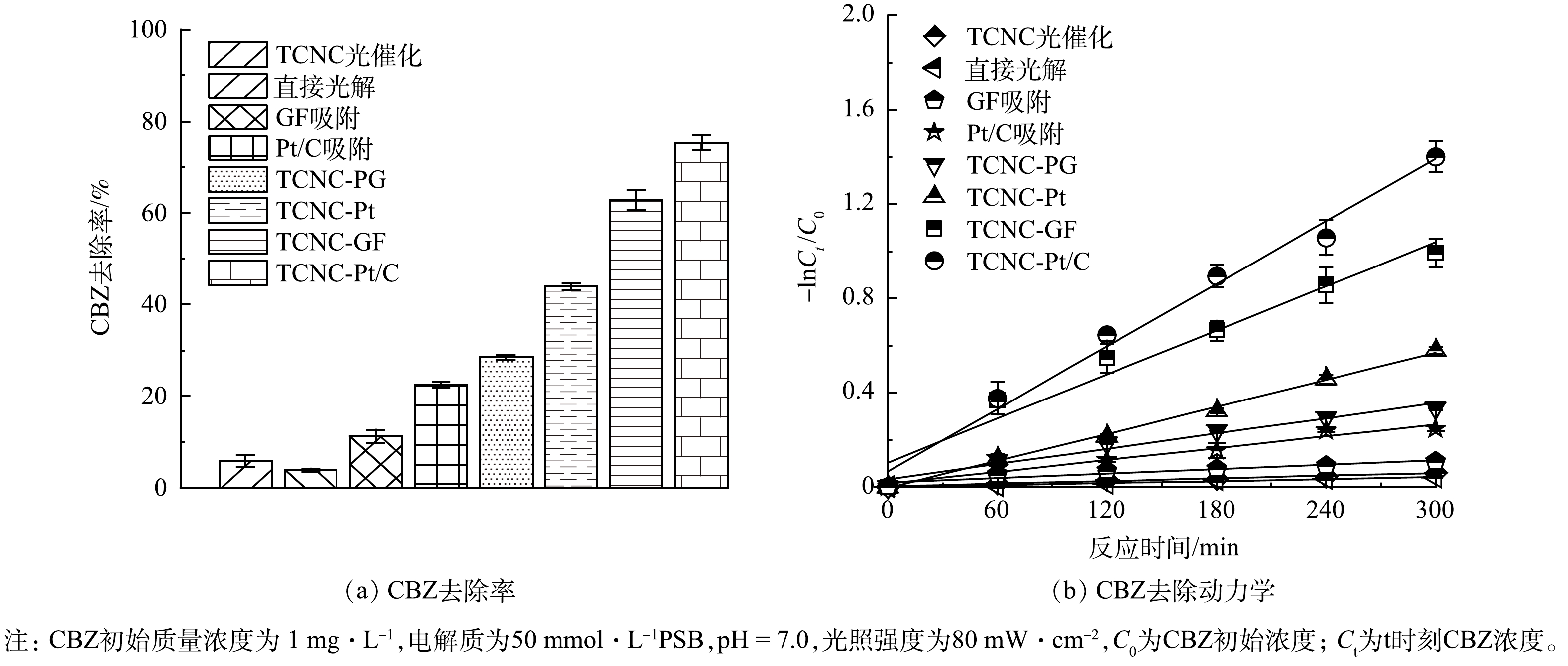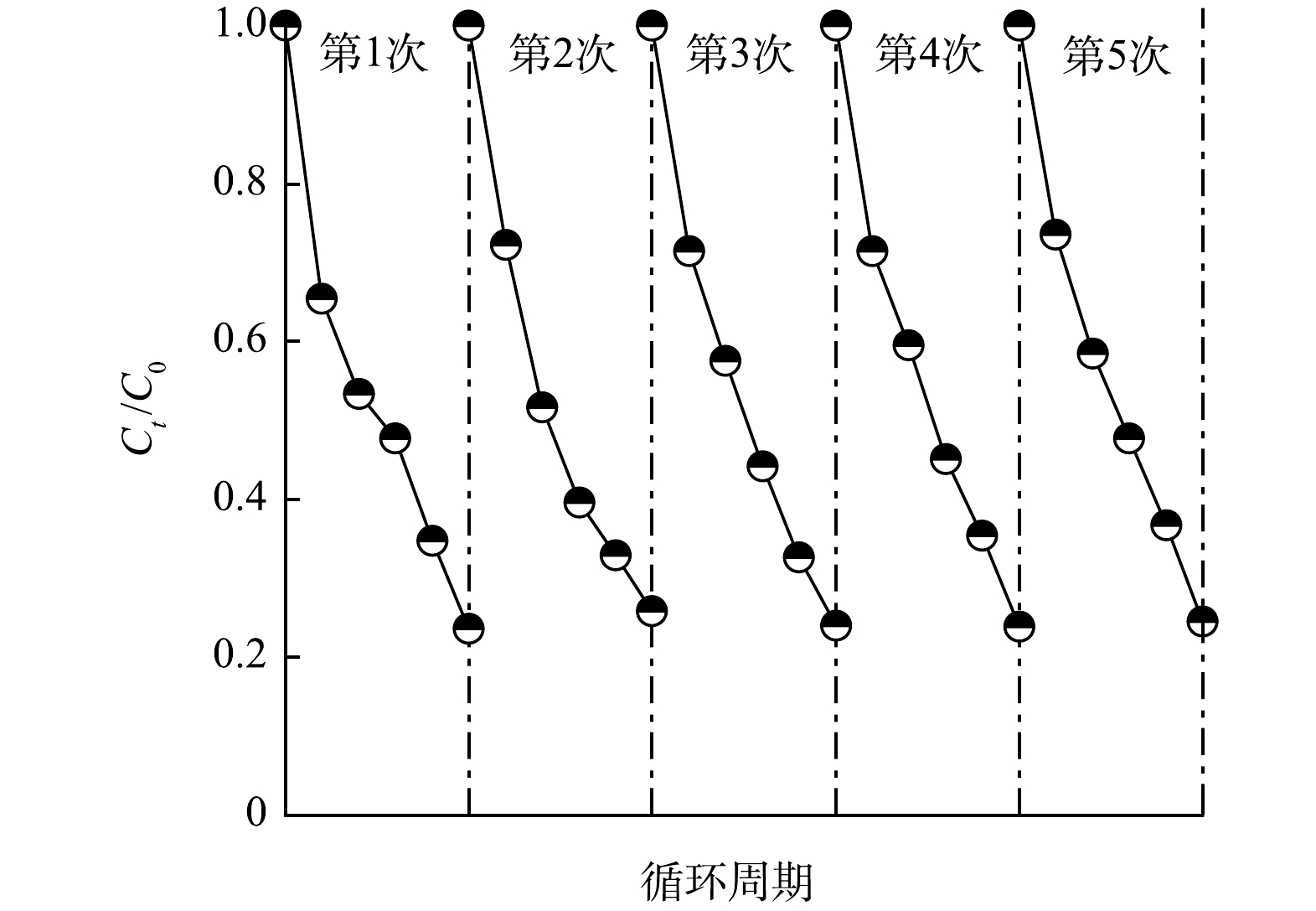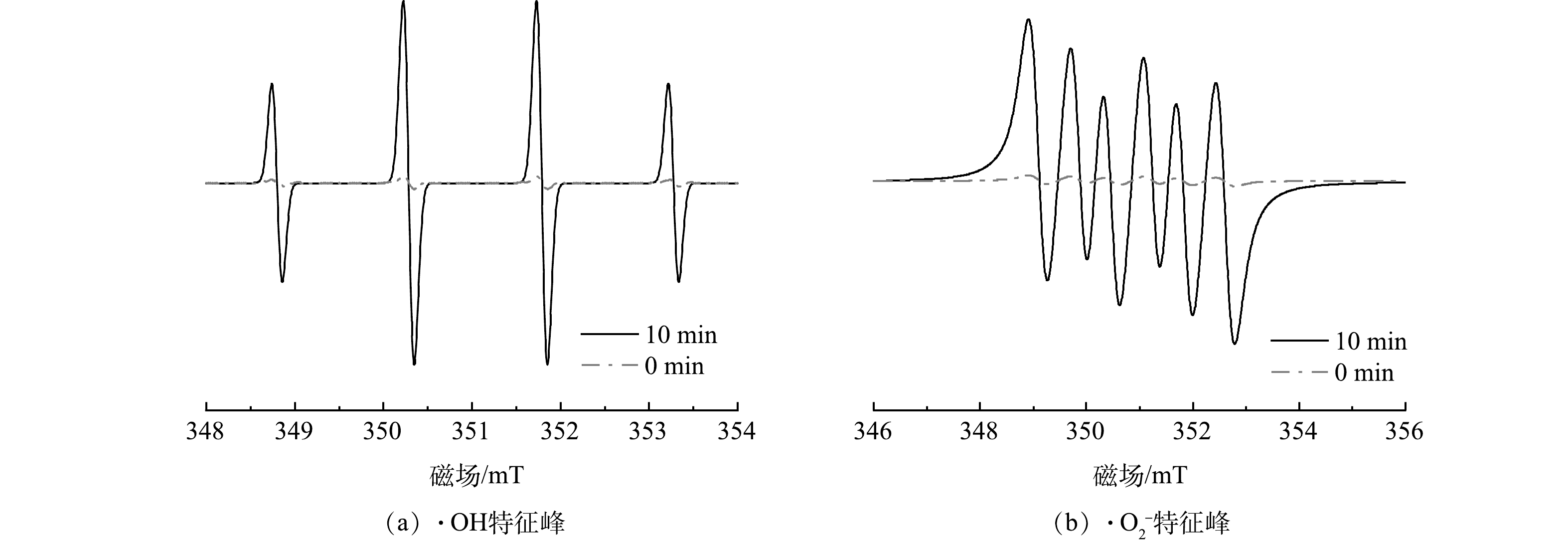-
卡马西平(carbamazepine,CBZ)是一种常见且重要的精神类药物,在临床上常用于控制癫痫的发作、三叉神经痛和舌咽神经痛,并且可以预防和治疗狂躁症和抑郁症,每年消耗量达1 214 t[1-2]。同时,CBZ也是水环境和城镇污水中典型的药物和个人护理用品(pharmaceutical and personal care products,PPCPs)类污染物。与众多PPCPs类污染物类似,CBZ具有难降解特性,其半衰期长达(990±10) d[3]。因此,CBZ随污水排放后,将在环境中持续存在,其在地表水和土壤中的残留质量浓度可高达830 μg·L−1[4-5]和50 μg·kg−1[3]。同时,CBZ还具有较强的生物累积性,在ng·L−1级别就会产生神经毒性、胚胎发育影响、器官损伤等显著的生态毒性效应,其在食物链的富集作用对水生生态系统和人体健康产生深远影响[6]。对于CBZ的处理技术,在传统的污水处理厂中,CBZ的去除率通常低于10%[7-8]。高级氧化技术(advanced oxidation processes,AOPs),包括Fenton氧化、超声氧化、臭氧氧化和紫外线/过硫酸盐氧化等,可原位生成强氧化剂(·OH、1O2、·O2−、O3、HOCl和SO4·−)[9-11],以实现CBZ的快速氧化降解。然而,能量和不稳定试剂的大量投入、二次污染物生成仍是AOPs面临的关键问题。因此,研发高效、低耗的CBZ降解技术,从受污染水体中有效去除CBZ等PPCPs类污染物、缓解其环境生态风险具有重要意义。
有研究表明,光电催化(photoelectrocatalysis,PEC)技术已被证明是应对能源危机和环境污染的一种重要AOPs方法[12]。PEC系统耦合了光催化过程和电化学过程,能有效解决电催化过程能耗高、光催化过程效能低的问题,提高有机污染物的降解效果。例如,WANG等[13]的研究证明,以TiO2为光阳极的PEC系统对CBZ的降解率为(73.1±1.7)%,高于光催化(photocatalysis,PC)和电催化(electrocatalysis,EC)工艺的总和。然而,以CBZ为代表的PPCPs污染物,其在污水中质量浓度为仅为ng·L−1~μg·L−1[14],要实现CBZ的高效降解往往需要投加更多的电能。近年来,光催化燃料电池(photocatalytic fuel cell,PFC)结合了光催化和传统燃料电池的原理,可在无需外加电能情况下,驱动有机污染物的光电催化降解过程,并可同步产生电能[15],其有望为水中PPCPs类污染物的高效、低耗去除提供新的解决方案。
对于PFC系统,研究表明通过改进阳极材料增加光电流是有限的,难以实现系统性能的大幅度提升,加之电子从光阳极迁移到阴极的由于动力学缓慢等原因无法快速消耗。阴极过程已成为整个PFC系统的限制性因素[16]。目前,PFC过程通常采用2种功能性阴极,一是催化氧气4电子还原反应的普通阴极,如ZHANG等[17]构建光催化燃料电池,在模拟太阳光照射下,CN-WO3/W阳极在1.2 V(相对于Ag/AgCl)下,以有机污染物为燃料,显示出6.1 mA·cm−2的稳态光电流密度,且对PFOA的降解率高达95%。二是进行2电子还原反应的H2O2电合成阴极,该阴极可以利用光阳极产生的电子在阴极表面选择性合成H2O2,通过类芬顿过程和光阳极作用,促进体系中ROS的生成和CBZ等水中微量有机污染物的降解[18-19]。然而,值得注意的是,在PFC系统中,阴阳极通过光电流密切相关,阴极的选择直接影响了系统产电和阳极光催化性能。O2/H2O2的标准电极电势为0.695 V vs SHE仅为O2/H2O的50%,因而从热力学角度来看,采用H2O2电合成阴极对于电能回收、光阳极空穴-电子有效分离和空穴有效利用是不利的。
因此,本研究主要以PFC系统高效低耗降解CBZ为目标,研究不同阴极对PFC系统产电、CBZ去除效能的影响,选择效能最优的阴极开展影响因素分析实验、并通过淬灭实验和中间产物分析,探究PFC系统对CBZ的降解机制,为PFC系统低耗高效去除水中的CBZ提供数据参考。
-
1)TiO2/g-C3N4/CQDs(TCNC)阳极的制备。本研究主要采用可见光相应的TCNC光阳极开展研究,具体制备步骤如下[20]:将方阻为7 Ω的FTO导电玻璃放入1 : 1 : 1的异丙醇:丙酮:超纯水混合液中,超声60 min后取出清洗;将40 mL去离子水与40 mL浓盐酸进行混合搅拌5 min,然后,加入1.35 mL钛酸四丁酯,再搅拌5 min,混合液放入Teflon高压反应釜中;然后把FTO导电面朝上放入反应釜中,烘箱中150 ℃反应5 h,随后取出并清洗干净;称取2.0 g二氰二胺放入坩埚当中,然后将负载了TiO2的导电玻璃导电面朝下放入坩埚当中;将坩埚放入马弗炉中550 ℃反应3 h,随后取出并清洗干净即得TiO2/g-C3N4阳极;在50 mL (1 mol·L−1)葡萄糖中加入50 mL (1mol·L−1)的NaOH,超声处理2 h得到棕色溶液,用盐酸调至中性即得CQDs水溶液;将TiO2/g-C3N4浸泡在CQDs溶液中并放入烘箱中60 ℃干燥10 h,即可得到TCNC阳极。
2)类芬顿空气扩散阴极(GF)的制备。称取45 mg铁锰铜三元催化剂(铁锰铜质量比为3 : 1 : 8)[21]和90 mg石墨再加入10 mL塑料离心管中,然后量取100 μL去离子水,800 μL 5%全氟磺酸溶液,400 μL异丙醇,漩涡振荡5 min。将混合物快速涂于防水透气碳布(单面涂敷了PTFE防水透气涂层)的碳纤维裸露面,室温干燥24 h,即获得类芬顿催化剂与石墨比例为1:2的GF阴极。此外,石墨电极(PG)为类芬顿催化剂与石墨比例为0:2的空气扩散阴极。
3)铂碳(Pt/C)空气扩散阴极的制备。称取15 mg 47.5% Pt催化剂和45 mg碳黑(XC-72R,美国卡波特有限公司)于塑料瓶中,加入50 μL去离子水振荡60 s,加400 μL 5% Nafion溶液,200 μL异丙醇,振荡摇匀,均匀涂在防水碳布的碳纤维裸露面,即获得载Pt量为0.5 mg·cm−2的Pt/C阴极。
-
以负载TCNC的导电玻璃为光阳极,选择功能性阴极,制备单室反应器,阴阳极的有效面积为7 cm2,反应器有效体积为14 mL,采用可见光LED白灯作为激发光源,光功率密度为80 mW·cm−2,CBZ初始质量浓度为1 mg·L−1,PFC运行时间为300 min。对比分析不同功能性阴极、不同条件反应对CBZ的去除效果。
-
1)材料表征。通过场发射扫描电镜(SU8010型,HITACHI 日立)观察空气阴极扩散层的表面形貌。通过自动比表面积和孔径分析仪(ASAP,
2460 3.01, Micromeritics USA)测量催化剂负载在阴极形成的孔径和比表面积。2)溶出实验。通过总有机碳分析仪(TOC-L,岛津)测定PFC系统运行过程中,溶出的的TOC浓度,通过电感耦合等离子体质谱仪(Aglient-
7800 ,安捷伦)测定溶出的金属离子浓度。3)光电性能测试。采用电化学工作站(DH7000型,江苏东华分析仪器有限公司)对光电化学性能进行了测试,测试项目包括线性扫描伏安扫描、功率密度曲线和电化学阻抗谱。
4)自由基分析。使用电子顺磁共振光谱仪(JES FA200,日本电子JEOL)对测试样品中的自由基进行分析,采用DMPO分别在水溶液和甲醇溶液中捕获·OH和·O2− [22];通过投加自由基淬灭剂[23]研究CBZ降解过程中·OH、·O2−和h+的贡献。
5) CBZ浓度和中间产物的测定。采用高效液相色谱法(Alliance e2695,沃特世科技有限公司)测定CBZ的浓度,色谱柱为C18色谱柱(4.6 mm×250 mm,5 μm,瑞典Akzo Nobel公司),流动相为60甲醇 : 40水(0.1%乙酸) (V : V),流速为1.0 mL·min−1,紫外检测器波长为280 nm,柱温35 ℃。中间产物采用超高效液相色谱-四极杆-静电场轨道阱高分辨质谱(UPLC-Q-Orbitrap HRMS)进行检测分析[24]。
-
在PFC系统中,有机物、H2O和OH−是电子主要来源。空穴氧化和光激发过程产生的电子可在阴阳极电势差驱动下,在PFC回路中定向移动,可有效抑制光催化剂中载流子复合,提高光催化效率和CBZ去除效率。如图1(a)所示,对于卡马西平CBZ直接光解和TCNC光催化过程,CBZ去除率较低,仅为(3.9±0.3)%和(5.8±1.3)%。值得关注的是,在PFC系统中,阴极材料会直接影响CBZ的去除效率。为了提升CBZ的降解效率,我们制备并比较了类芬顿空气扩散电极(GF电极)和Pt/C空气扩散电极两种功能性阴极。首先,该两种阴极对CBZ都具有一定的吸附效果。从阴极表面的SEM图(图2)中可以看出,GF阴极和Pt/C阴极表面都均匀负载了催化剂,且Pt/C阴极表面的粗糙程度大于GF阴极。同时,Pt/C阴极具有较小的孔径、更大的比表面积和微孔体积(表1),因此Pt/C表现为更高的吸附去除效果。实验结果表明,Pt/C阴极和GF阴极对CBZ的吸附去除效率分别为(22.5±0.8)%和(11.3±1.4)%。
对于光电催化过程,当以铂(Pt)电极作为阴极构建PFC系统后,光阳极生成的光生电子传递给阴极,在阴极上发生O2+4H++4e− → H2O反应,CBZ去除率显著提升至(43.9±0.7)%。而当采用Pt/C空气扩散电极代替Pt电极,由于其优越的氧气扩散性能[25],强化了阴极表面电子转移,CBZ去除率可进一步提升至(75.2±1.6)%。然而,当采用石墨(PG)空气扩散阴极,由于其主要催化的是氧气2电子还原产H2O2的过程[26],系统对光生电子的驱动力下降,CBZ去除率仅为(28.5±0.6)%。虽然通过在阴极材料中引入类芬顿催化剂制备GF阴极,可活化H2O2并强化ROS生成,使CBZ去除率提升至(62.8±2.2)%,但其去除反应动力学常数(Kobs)仅为Pt/C的70.6%(图1(b))。结果表明在PFC系统中,相对于TCNC - GF系统利用类芬顿过程强化ROS生成,TCNC - Pt/C系统则是通过提升阴极的电子转移能力,强化光电流和载流子分离能力,对CBZ的强化去除更为有利。因此,TCNC - Pt/C系统对CBZ具有更高的去除效能。此外,为了佐证电极材料在反应过程中的稳定性,我们同时开展了TOC和金属溶出实验,如图3所示,PFC系统运行300 min后,GF阴极和Pt/C阴极的TOC溶出质量浓度分别为(1.8±0.3) mg·L−1和(3.4±0.4) mg·L−1,而GF阴极的金属溶出质量浓度为134.3 μg·L−1,远大于Pt/C阴极的金属溶出质量浓度(1.4 μg·L−1),因此,从材料稳定性方面考虑,本研究选择Pt/C阴极构建PFC体系。
-
对于PFC系统,处理污染物去除效率外,产电效能也是衡量系统性能的关键指标,主要包括开路电压(Voc)、短路光电流密度(Jsc)、最大功率密度(Pmax)等关键参数[27]。如图4(a)所示,PG阴极和GF阴极的Voc分别为185.6 mV和187.5 mV,而Pt阴极和Pt/C阴极的Voc为375.5 mV和401.2 mV。Voc主要反映PFC阳极和阴极之间的电势差,主要取决于阴极反应。PG和GF阴极主要进行氧气的2电子还原反应,E0 = 0.68 V,而对于Pt和Pt/C阴极则主要为氧气4电子还原反应,E0 = 1.23 V。理论上,Pt和Pt/C阴极的电势约为PG和GF阴极的2倍,则Pt和Pt/C阴极的Voc也是PG和GF阴极的2倍左右。Jsc可以间接反映体系中的由阳极传递至阴极的电子数量,主要取决于阴阳极电势差以及PFC的内阻,阳极空穴的有效消耗以及阴极电子的迅速转化,可以有效提高体系的Jsc以及Pmax[27],本研究中,Pt/C阴极由于较高的阴极电势以及空气扩散阴极的优势,表现出较高的Jsc (15.9 μA·cm−2),约为PG和GF阴极的2倍,为Pt阴极的3倍。表明,Pt/C阴极可显著增大光电流,从而提升CBZ的去除效果。相似地,TCNC - Pt/C系统的Pmax达1.5 μW·cm−2,分别是TCNC - Pt、TCNC - PG和TCNC - GF系统的5、3.75和3倍。因此,Pt/C阴极有利于发电。
-
进一步对不同PFC体系的光电化学特性开展研究,各功能性阴极的线性伏安扫描结果表明(图5(a)),阴极表面的电子转移能力为Pt/C > PG > GF > Pt,由于采用相同的光阳极,各系统的电荷转移能力与阴极表面的电子转移能力相一致,Pt/C表现出较高的光电流,与J-V曲线结果一致,证明Pt/C阴极具有优异的电子转移能力和良好的氧气还原活性[28]。此外,GF与PG相比,电流没有明显增加,说明PG阴极添加铁锰铜金属催化剂后,并不能提升系统的电荷转移能力,TCNC - GF对于CBZ去除效能的提升主要是由于PFC体系中的ROS产量的增加。同时,电化学阻抗图谱分析结果(图5(b))表明,Pt的圆弧最大,其Rct达170 Ω,而Pt/C的Rct仅为0.5 Ω,远低于PG(6.4 Ω)和GF(8.0 Ω)阴极,Pt/C阴极与其他3种功能性阴极相比的低电阻,解释了其在PFC中的较高功率输出。因此,本研究后续选择Pt/C作为阴极,研究PFC系统的影响因素及CBZ降解机制分析。
-
1) CBZ初始质量浓度对PFC体系去除CBZ效果的影响。底物初始质量浓度对TCNC-Pt/C系统的影响如图6所示,当CBZ初始质量浓度为0.5、1、2和4 mg·L−1时,反应300 min后对应的CBZ去除率分别为(40.5±1.7)%、(75.3±1.6)%、(75.4±0.2)%和(76.2±0.8)%,Kobs分别为0.001 7、0.004 4、0.004 3和0.004 7 min−1。随着CBZ初始质量浓度由0.5 mg·L−1增加至1 mg·L−1,CBZ的去除率提升约86%,但当CBZ初始质量浓度大于1 mg·L−1,CBZ去除效果无明显变化。上述结果表明,在PFC系统中,该CBZ浓度范围对其去除率的影响较低,推测由于本研究采用的光电催化体系中可以产生充足的ROS,使CBZ与阳极活性位点或者ROS碰撞的概率趋于稳定。
2)电解液种类对PFC体系去除CBZ效果的影响。PFC系统中电解液的主要作用是传导离子,降低体系的欧姆内阻,但同时电解液的种类也会影响PFC去除CBZ的效能。如图7所示,当电解液分别为50 mmol·L−1的NaNO3、NaCl、Na2SO4和PBS时,反应300 min后CBZ去除率分别为54.9%、83.8%、63.0%和75.3%。上诉CBZ去除率的差异可以通过体系中不同ROS的形成来解释[29]。当电解质为NaCl时,CBZ去除量最高,反应速率达0.005 8 min−1,推测其原因是Cl−能在PFC体系中能生成活性氯自由基 (Cl2·−和HOCl) [30],从而促进CBZ的去除。当电解质为Na2SO4时,体系中生成·SO4−和·OH,虽然可提升CBZ的去除,但也可能增加电子-空穴对复合的可能性[31],从而使CBZ的降解效率下降。此外,电解液携带电荷的数量可直接影响PFC的产电效能并对CBZ的去除产生影响,在相同的摩尔浓度下,电解液的电导率为PBS > Na2SO4 > NaNO3,因此,PBS携带电荷能力更强,因此,系统产生的光电流更高[32],强化了光电子和空穴的分离,CBZ去除效率较高。
3)光照强度对PFC体系去除CBZ效果的影响。当光照强度为10、20、40、60和80 mW·cm−2时,PFC运行结果如图8所示,随着光照强度的逐渐增大,CBZ的去除率也在不断增加。产生这种结果的原因是由于光电催化反应是一种界面反应,随着光照强度的增大,照射到阳极催化剂表面的光子数量就会增多,激发得到的光电流密度也随之增大,同时促进了光生电子对的分离,激发出更多的光生空穴,进而产生更多的ROS促进CBZ的去除[33]。此外,光照强度的增大也会使PFC体系整体的温度上升,加速CBZ和ROS的布朗运动,增加两者的碰撞、反应概率,从而加速了CBZ的去除。
4)腐殖酸的初始质量浓度对PFC体系去除CBZ效果的影响。为了模拟自然水体中天然有机物存在条件下,PFC系统对CBZ的去除效果,本文通过添加不同质量浓度(0、5、10、20和40 mg·L−1)的腐殖酸(HA),考察其对TCNC-Pt/C系统去除CBZ的影响。实验结果如图9所示,在上述HA浓度下,CBZ去除率分别为75.3%、24.6%、28.2%、41.0%和50.4%。整体上,腐殖酸作为大分子有机质会和CBZ竞争活性位点和ROS,因此HA的存在对CBZ的去除起抑制作用[34];然而,随着腐殖酸质量浓度的增加,CBZ的去除效率有所提升,这主要归因于HA是水生环境中常见的光敏有机物,容易被激发产生活性中间体,如·O2−和·OH,从而促进有机污染物的光降解过程[35]。
5)电流强度和负载对CBZ去除效果的影响。在可见光激发下,TCNC-Pt/C系统可产生0.16 mA的电流,当强制将体系电流提升一倍时,CBZ的去除效率升至85.9%(图10(a)),因为随着体系电流的增加,会加速阳极的电子向阴极转移,进一步抑制光生空穴-电子复合,从而促进CBZ的去除[36]。但当电流提升2倍时,CBZ去除效率仅为81.9%,CBZ去除率出现降低的情况,这可能由于过高偏置电位下空间电荷层的重新分配导致光生载流子的减少[37]。此外,负载也会对PFC系统造成影响,实验结果如图10(b)所示,当负载电阻由0 增加到100 Ω时,CBZ去除速率由0.004 0 min−1降到0.002 6 min−1,上述结果表明PFC的CBZ去除效能依赖于阳极和阴极之间的电荷转移,并受到体系负载的影响。
6)TCNC - Pt/C系统循环稳定性实验。为了评估TCNC - Pt/C系统的实际应用前景,对该系统进行循环稳定性测试,结果如图11所示。经过5次循环周期,TCNC - Pt/C系统对于CBZ的去除效率从第1次的76.4%降到第5次的75.5%,仍然具有良好的去除效果。
-
如图12所示,加入10 mmol·L−1的异丙醇、对苯醌和草酸钠分别对·OH、·O2−和h+进行淬灭时,CBZ的去除效率由75.3%分别下降到35%、34%和67.3%,Kobs从0.004 4 min−1(R2 = 0.985)分别下降至0.001 3 min−1(R2 = 0.959)、0.001 1 min−1(R2 = 0.873)和0.003 3 min−1(R2 = 0.951)。因此·O2−、·OH和h+对于CBZ降解的贡献度分别为:54.8%、53.5%和10.6%。这是因为TCNC阳极产生的·O2−和·OH起主要作用,与SU[19]结果一致。
为了验证TCNC - Pt/C系统在降解CBZ过程中产生的·O2−和·OH,利用电子顺磁共振光谱仪(EPR)检测反应10 min前后的ROS产生情况。在图13中可以清晰地观察到峰强比例为1 : 2 : 2 : 1的DMPO - ·OH特征峰和1 : 1 : 1 : 1的DMPO - ·O2− 特征峰,证明TCNC-Pt/C系统中存在羟基自由基和超氧自由基。
-
利用UPLC-Q-Orbitrap HRMS检测CBZ在降解过程中的中间产物(P1-P20),其可能得降解路径如图14所示。CBZ在·O2−和·OH作用下,可发生脱氢、羟基化和酰胺基裂解等反应,形成六种化合物(P1-P6)。例如CBZ可被ROS攻击而断键生成P1或P2,或者CBZ的杂环羟基化形成P5和P6两种同分异构体。P1逐步氧化成P7 → P12,再被氧化成P18。主要鉴定的中间体是P3(10,11- 环氧卡马西平),它是CBZ降解过程中最常检测到的中间产物[38]。P3可以通过环收缩形成P9,而后进行酰胺基丢失过程形成P20。同时,P3也可以水解形成P4,或者通过杂环开环过程转化为P9,然后通过P9的亲电芳香取代的分子内环化得到P13。P13进一步发生乙酰基的裂解以形成P16,或者P13的醛基被氧化以形成P17。P16和P17都可以通过醛基和胺/羧基的裂解转化为P18。最后CBZ被降解成H2O、CO[39-40]等小分子物质。
-
对于CBZ的常规处理技术,如物理吸附法,145 μg·L−1CBZ去除效率可达43% [41],然而该方法只能转移水中的CBZ,无法实现其转化和降解;若采用生物处理技术,在10 d内仅能使1 mg·L−1CBZ下降30%左右[42]。对于高级氧化法,常规类芬顿法需要投加3.4 g·L−1的H2O2和1.0 g·L−1Fe3O4才能实现CBZ的去除[43]。在提供1.8 mA·cm−2电流密度的条件下,利用电芬顿技术能去除水中66%的CBZ(12 mg·L−1)[44]。而在本研究中,采用Pt/C作为功能性阴极的PFC系统,在无需投入额外电能和大量药剂的情况下,仅需提供电解质即可实现75.3%的CBZ去除效率,在电能消耗、药剂投加和二次污染产生等方面具有优势。
然而,本研究提供的TCNC - Pt/C系统,在CBZ去除过程中仅能产生0.16 mA的电流,功率密度仅为1.5 μW·cm−2。考虑到高电流密度对CBZ去除的促进作用,因此可进一步针对光阳极和阴极材料、反应器结构、运行参数等方面进行优化,以提升PFC系统的电流密度、电能产率以及CBZ去除效率。其次,PFC对实际废水中CBZ等PPCPs类污染物的去除效率和关键性影响因素也需进一步深入研究,以实现PFC在污水处理和生态修复中的推广应用。
-
1)选择Pt/C为功能性阴极的PFC系统,反应300 min后,1.0 mg·L−1的CBZ去除效率达75.3%,优于其他系统和功能性阴极。
2)通过功率密度曲线、LSV和EIS分析,证实了以TCNC为阳极,Pt/C为阴极,具有良好的光电催化性能和电能回收潜力,最大功率密度为1.5 μW·cm−2。
3)获得TCNC - Pt/C系统的最佳操作条件为50 mmol·L−1的PBS电解质和80 mW·cm−2的光照强度。在TCNC - Pt/C系统中,腐殖酸会与CBZ竞争ROS,降低CBZ的去除效能,但同时腐殖酸的光敏特性可能对去除CBZ有一定的促进作用。强制提升电流强度在一定程度上可以促进CBZ的去除,但作用并不明显;且负载会降低CBZ的去除效率。重复批次实验表明TCNC - Pt/C系统具有良好的稳定性,可以实现CBZ的持续去除。
4) TCNC - Pt/C体系在降解CBZ的过程中起主要作用的ROS是·O2−和·OH,贡献率分别达54.8%和53.5%。ROS主要通过脱氢、羟基化和酰胺基裂解等反应对CBZ进行降解,明确了CBZ的主要降解路径。
功能性阴极对光催化燃料电池去除卡马西平的影响
Effect of functional cathodes on carbamazepine removal in the photocatalytic fuel cell
-
摘要: 光催化燃料电池(PFC)具有降解污染物和同步电能回收的特点,而阴极的选择直接影响了系统产电和阳极光催化性能。因此该研究以TiO2/g-C3N4/CQDs薄膜电极(TCNC)作为光阳极,比较不同功能性阴极构建的PFC体系对卡马西平(CBZ)的处理效果,在80 mW·cm−2的LED白光照射下,经过300 min处理后,对比石墨阴极(PG)、类芬顿空气扩散阴极(GF)和普通铂阴极(Pt),碳载铂空气扩散阴极(Pt/C)具有更好的效果,对CBZ的去除效率达到75.2%。同时,TCNC - Pt/C体系具有较高的电能回收潜力,最大功率密度达1.5 μW·cm−2,是其他3种阴极的3~5倍。进一步探究了CBZ初始浓度、电解质种类、光照强度、腐殖酸和电流强度对TCNC-Pt/C去除CBZ的影响。根据EPR结果和淬灭实验结果以及对中间产物的分析推测,确定在TCNC - Pt/C系统降解去除CBZ的过程中,起主要作用的是·O2−和·OH,并获得了CBZ的主要降解路径。本研究为PFC系统低耗高效去除水中的CBZ提供数据参考。Abstract: Photocatalytic fuel cell (PFC) has the great potential for simultaneous refractory organic pollutants degradation and energy recovery. The cathode may affect the electricity production and anode photocatalytic performance of this system. In this study, TiO2/g-C3N4/CQDs film electrode (TCNC) was used as the photoanode of the PFC, and the effect of different functional cathodes on the removal of carbamazepine (CBZ) was investigated. Under the power intensity of 80 mW·cm−2 (LED white light), 300 min treatment by PFC with carbon-loaded platinum air diffusing cathode (Pt/C) resulted in higher CBZ removal efficiency of 75.2% than that with graphite cathode (PG), Fenton-like air diffusing cathode (GF) and ordinary platinum cathode (Pt). At the same time, TCNC-Pt/C system had higher energy recovery with the Pmax of 1.5 μW·cm−2, which was 3-5 times of the PFC systems with other three cathodes. Furthermore, the effects of initial CBZ concentration, electrolyte type, power intensity, humic acid and current intensity on the removal of CBZ by the TCNC-Pt/C system were investigated. Based on the EPR results, quenching experiments and intermediate product analysis, it was suggested that ·O2− and ·OH were the dominated reactive species leading to CBZ degradation in the TCNC-Pt/C system, and the probable degradation pathway of CBZ was identified. This study may provide a data reference for the low-consumption and high-effective removal of CBZ by the PFC system.
-
Key words:
- photocatalytic fuel cell /
- CBZ /
- functional cathode /
- energy recovery
-
卡马西平(carbamazepine,CBZ)是一种常见且重要的精神类药物,在临床上常用于控制癫痫的发作、三叉神经痛和舌咽神经痛,并且可以预防和治疗狂躁症和抑郁症,每年消耗量达1 214 t[1-2]。同时,CBZ也是水环境和城镇污水中典型的药物和个人护理用品(pharmaceutical and personal care products,PPCPs)类污染物。与众多PPCPs类污染物类似,CBZ具有难降解特性,其半衰期长达(990±10) d[3]。因此,CBZ随污水排放后,将在环境中持续存在,其在地表水和土壤中的残留质量浓度可高达830 μg·L−1[4-5]和50 μg·kg−1[3]。同时,CBZ还具有较强的生物累积性,在ng·L−1级别就会产生神经毒性、胚胎发育影响、器官损伤等显著的生态毒性效应,其在食物链的富集作用对水生生态系统和人体健康产生深远影响[6]。对于CBZ的处理技术,在传统的污水处理厂中,CBZ的去除率通常低于10%[7-8]。高级氧化技术(advanced oxidation processes,AOPs),包括Fenton氧化、超声氧化、臭氧氧化和紫外线/过硫酸盐氧化等,可原位生成强氧化剂(·OH、1O2、·O2−、O3、HOCl和SO4·−)[9-11],以实现CBZ的快速氧化降解。然而,能量和不稳定试剂的大量投入、二次污染物生成仍是AOPs面临的关键问题。因此,研发高效、低耗的CBZ降解技术,从受污染水体中有效去除CBZ等PPCPs类污染物、缓解其环境生态风险具有重要意义。
有研究表明,光电催化(photoelectrocatalysis,PEC)技术已被证明是应对能源危机和环境污染的一种重要AOPs方法[12]。PEC系统耦合了光催化过程和电化学过程,能有效解决电催化过程能耗高、光催化过程效能低的问题,提高有机污染物的降解效果。例如,WANG等[13]的研究证明,以TiO2为光阳极的PEC系统对CBZ的降解率为(73.1±1.7)%,高于光催化(photocatalysis,PC)和电催化(electrocatalysis,EC)工艺的总和。然而,以CBZ为代表的PPCPs污染物,其在污水中质量浓度为仅为ng·L−1~μg·L−1[14],要实现CBZ的高效降解往往需要投加更多的电能。近年来,光催化燃料电池(photocatalytic fuel cell,PFC)结合了光催化和传统燃料电池的原理,可在无需外加电能情况下,驱动有机污染物的光电催化降解过程,并可同步产生电能[15],其有望为水中PPCPs类污染物的高效、低耗去除提供新的解决方案。
对于PFC系统,研究表明通过改进阳极材料增加光电流是有限的,难以实现系统性能的大幅度提升,加之电子从光阳极迁移到阴极的由于动力学缓慢等原因无法快速消耗。阴极过程已成为整个PFC系统的限制性因素[16]。目前,PFC过程通常采用2种功能性阴极,一是催化氧气4电子还原反应的普通阴极,如ZHANG等[17]构建光催化燃料电池,在模拟太阳光照射下,CN-WO3/W阳极在1.2 V(相对于Ag/AgCl)下,以有机污染物为燃料,显示出6.1 mA·cm−2的稳态光电流密度,且对PFOA的降解率高达95%。二是进行2电子还原反应的H2O2电合成阴极,该阴极可以利用光阳极产生的电子在阴极表面选择性合成H2O2,通过类芬顿过程和光阳极作用,促进体系中ROS的生成和CBZ等水中微量有机污染物的降解[18-19]。然而,值得注意的是,在PFC系统中,阴阳极通过光电流密切相关,阴极的选择直接影响了系统产电和阳极光催化性能。O2/H2O2的标准电极电势为0.695 V vs SHE仅为O2/H2O的50%,因而从热力学角度来看,采用H2O2电合成阴极对于电能回收、光阳极空穴-电子有效分离和空穴有效利用是不利的。
因此,本研究主要以PFC系统高效低耗降解CBZ为目标,研究不同阴极对PFC系统产电、CBZ去除效能的影响,选择效能最优的阴极开展影响因素分析实验、并通过淬灭实验和中间产物分析,探究PFC系统对CBZ的降解机制,为PFC系统低耗高效去除水中的CBZ提供数据参考。
1. 材料与方法
1.1 阳极与阴极的制备
1)TiO2/g-C3N4/CQDs(TCNC)阳极的制备。本研究主要采用可见光相应的TCNC光阳极开展研究,具体制备步骤如下[20]:将方阻为7 Ω的FTO导电玻璃放入1 : 1 : 1的异丙醇:丙酮:超纯水混合液中,超声60 min后取出清洗;将40 mL去离子水与40 mL浓盐酸进行混合搅拌5 min,然后,加入1.35 mL钛酸四丁酯,再搅拌5 min,混合液放入Teflon高压反应釜中;然后把FTO导电面朝上放入反应釜中,烘箱中150 ℃反应5 h,随后取出并清洗干净;称取2.0 g二氰二胺放入坩埚当中,然后将负载了TiO2的导电玻璃导电面朝下放入坩埚当中;将坩埚放入马弗炉中550 ℃反应3 h,随后取出并清洗干净即得TiO2/g-C3N4阳极;在50 mL (1 mol·L−1)葡萄糖中加入50 mL (1mol·L−1)的NaOH,超声处理2 h得到棕色溶液,用盐酸调至中性即得CQDs水溶液;将TiO2/g-C3N4浸泡在CQDs溶液中并放入烘箱中60 ℃干燥10 h,即可得到TCNC阳极。
2)类芬顿空气扩散阴极(GF)的制备。称取45 mg铁锰铜三元催化剂(铁锰铜质量比为3 : 1 : 8)[21]和90 mg石墨再加入10 mL塑料离心管中,然后量取100 μL去离子水,800 μL 5%全氟磺酸溶液,400 μL异丙醇,漩涡振荡5 min。将混合物快速涂于防水透气碳布(单面涂敷了PTFE防水透气涂层)的碳纤维裸露面,室温干燥24 h,即获得类芬顿催化剂与石墨比例为1:2的GF阴极。此外,石墨电极(PG)为类芬顿催化剂与石墨比例为0:2的空气扩散阴极。
3)铂碳(Pt/C)空气扩散阴极的制备。称取15 mg 47.5% Pt催化剂和45 mg碳黑(XC-72R,美国卡波特有限公司)于塑料瓶中,加入50 μL去离子水振荡60 s,加400 μL 5% Nafion溶液,200 μL异丙醇,振荡摇匀,均匀涂在防水碳布的碳纤维裸露面,即获得载Pt量为0.5 mg·cm−2的Pt/C阴极。
1.2 CBZ的去除实验
以负载TCNC的导电玻璃为光阳极,选择功能性阴极,制备单室反应器,阴阳极的有效面积为7 cm2,反应器有效体积为14 mL,采用可见光LED白灯作为激发光源,光功率密度为80 mW·cm−2,CBZ初始质量浓度为1 mg·L−1,PFC运行时间为300 min。对比分析不同功能性阴极、不同条件反应对CBZ的去除效果。
1.3 分析和计算方法
1)材料表征。通过场发射扫描电镜(SU8010型,HITACHI 日立)观察空气阴极扩散层的表面形貌。通过自动比表面积和孔径分析仪(ASAP,
2460 3.01, Micromeritics USA)测量催化剂负载在阴极形成的孔径和比表面积。2)溶出实验。通过总有机碳分析仪(TOC-L,岛津)测定PFC系统运行过程中,溶出的的TOC浓度,通过电感耦合等离子体质谱仪(Aglient-
7800 ,安捷伦)测定溶出的金属离子浓度。3)光电性能测试。采用电化学工作站(DH7000型,江苏东华分析仪器有限公司)对光电化学性能进行了测试,测试项目包括线性扫描伏安扫描、功率密度曲线和电化学阻抗谱。
4)自由基分析。使用电子顺磁共振光谱仪(JES FA200,日本电子JEOL)对测试样品中的自由基进行分析,采用DMPO分别在水溶液和甲醇溶液中捕获·OH和·O2− [22];通过投加自由基淬灭剂[23]研究CBZ降解过程中·OH、·O2−和h+的贡献。
5) CBZ浓度和中间产物的测定。采用高效液相色谱法(Alliance e2695,沃特世科技有限公司)测定CBZ的浓度,色谱柱为C18色谱柱(4.6 mm×250 mm,5 μm,瑞典Akzo Nobel公司),流动相为60甲醇 : 40水(0.1%乙酸) (V : V),流速为1.0 mL·min−1,紫外检测器波长为280 nm,柱温35 ℃。中间产物采用超高效液相色谱-四极杆-静电场轨道阱高分辨质谱(UPLC-Q-Orbitrap HRMS)进行检测分析[24]。
2. 结果与讨论
2.1 DP、PC、PFC体系对CBZ的去除影响
在PFC系统中,有机物、H2O和OH−是电子主要来源。空穴氧化和光激发过程产生的电子可在阴阳极电势差驱动下,在PFC回路中定向移动,可有效抑制光催化剂中载流子复合,提高光催化效率和CBZ去除效率。如图1(a)所示,对于卡马西平CBZ直接光解和TCNC光催化过程,CBZ去除率较低,仅为(3.9±0.3)%和(5.8±1.3)%。值得关注的是,在PFC系统中,阴极材料会直接影响CBZ的去除效率。为了提升CBZ的降解效率,我们制备并比较了类芬顿空气扩散电极(GF电极)和Pt/C空气扩散电极两种功能性阴极。首先,该两种阴极对CBZ都具有一定的吸附效果。从阴极表面的SEM图(图2)中可以看出,GF阴极和Pt/C阴极表面都均匀负载了催化剂,且Pt/C阴极表面的粗糙程度大于GF阴极。同时,Pt/C阴极具有较小的孔径、更大的比表面积和微孔体积(表1),因此Pt/C表现为更高的吸附去除效果。实验结果表明,Pt/C阴极和GF阴极对CBZ的吸附去除效率分别为(22.5±0.8)%和(11.3±1.4)%。
表 1 GF阴极和Pt/C阴极的比表面积和孔径分析Table 1. Specific surface area and pore analysis of GF and Pt/C cathodes阴极 BET面积/(m2·g−1) 孔径/nm 微孔体积/(cm3·g−1) GF阴极 9.897 6 11.730 7 0.053 539 Pt/C阴极 11.763 6 10.791 9 0.069 410 对于光电催化过程,当以铂(Pt)电极作为阴极构建PFC系统后,光阳极生成的光生电子传递给阴极,在阴极上发生O2+4H++4e− → H2O反应,CBZ去除率显著提升至(43.9±0.7)%。而当采用Pt/C空气扩散电极代替Pt电极,由于其优越的氧气扩散性能[25],强化了阴极表面电子转移,CBZ去除率可进一步提升至(75.2±1.6)%。然而,当采用石墨(PG)空气扩散阴极,由于其主要催化的是氧气2电子还原产H2O2的过程[26],系统对光生电子的驱动力下降,CBZ去除率仅为(28.5±0.6)%。虽然通过在阴极材料中引入类芬顿催化剂制备GF阴极,可活化H2O2并强化ROS生成,使CBZ去除率提升至(62.8±2.2)%,但其去除反应动力学常数(Kobs)仅为Pt/C的70.6%(图1(b))。结果表明在PFC系统中,相对于TCNC - GF系统利用类芬顿过程强化ROS生成,TCNC - Pt/C系统则是通过提升阴极的电子转移能力,强化光电流和载流子分离能力,对CBZ的强化去除更为有利。因此,TCNC - Pt/C系统对CBZ具有更高的去除效能。此外,为了佐证电极材料在反应过程中的稳定性,我们同时开展了TOC和金属溶出实验,如图3所示,PFC系统运行300 min后,GF阴极和Pt/C阴极的TOC溶出质量浓度分别为(1.8±0.3) mg·L−1和(3.4±0.4) mg·L−1,而GF阴极的金属溶出质量浓度为134.3 μg·L−1,远大于Pt/C阴极的金属溶出质量浓度(1.4 μg·L−1),因此,从材料稳定性方面考虑,本研究选择Pt/C阴极构建PFC体系。
2.2 PFC体系的电池性能分析
对于PFC系统,处理污染物去除效率外,产电效能也是衡量系统性能的关键指标,主要包括开路电压(Voc)、短路光电流密度(Jsc)、最大功率密度(Pmax)等关键参数[27]。如图4(a)所示,PG阴极和GF阴极的Voc分别为185.6 mV和187.5 mV,而Pt阴极和Pt/C阴极的Voc为375.5 mV和401.2 mV。Voc主要反映PFC阳极和阴极之间的电势差,主要取决于阴极反应。PG和GF阴极主要进行氧气的2电子还原反应,E0 = 0.68 V,而对于Pt和Pt/C阴极则主要为氧气4电子还原反应,E0 = 1.23 V。理论上,Pt和Pt/C阴极的电势约为PG和GF阴极的2倍,则Pt和Pt/C阴极的Voc也是PG和GF阴极的2倍左右。Jsc可以间接反映体系中的由阳极传递至阴极的电子数量,主要取决于阴阳极电势差以及PFC的内阻,阳极空穴的有效消耗以及阴极电子的迅速转化,可以有效提高体系的Jsc以及Pmax[27],本研究中,Pt/C阴极由于较高的阴极电势以及空气扩散阴极的优势,表现出较高的Jsc (15.9 μA·cm−2),约为PG和GF阴极的2倍,为Pt阴极的3倍。表明,Pt/C阴极可显著增大光电流,从而提升CBZ的去除效果。相似地,TCNC - Pt/C系统的Pmax达1.5 μW·cm−2,分别是TCNC - Pt、TCNC - PG和TCNC - GF系统的5、3.75和3倍。因此,Pt/C阴极有利于发电。
2.3 PFC体系的光电化学特性分析
进一步对不同PFC体系的光电化学特性开展研究,各功能性阴极的线性伏安扫描结果表明(图5(a)),阴极表面的电子转移能力为Pt/C > PG > GF > Pt,由于采用相同的光阳极,各系统的电荷转移能力与阴极表面的电子转移能力相一致,Pt/C表现出较高的光电流,与J-V曲线结果一致,证明Pt/C阴极具有优异的电子转移能力和良好的氧气还原活性[28]。此外,GF与PG相比,电流没有明显增加,说明PG阴极添加铁锰铜金属催化剂后,并不能提升系统的电荷转移能力,TCNC - GF对于CBZ去除效能的提升主要是由于PFC体系中的ROS产量的增加。同时,电化学阻抗图谱分析结果(图5(b))表明,Pt的圆弧最大,其Rct达170 Ω,而Pt/C的Rct仅为0.5 Ω,远低于PG(6.4 Ω)和GF(8.0 Ω)阴极,Pt/C阴极与其他3种功能性阴极相比的低电阻,解释了其在PFC中的较高功率输出。因此,本研究后续选择Pt/C作为阴极,研究PFC系统的影响因素及CBZ降解机制分析。
2.4 PFC系统对CBZ去除过程的影响因素分析
1) CBZ初始质量浓度对PFC体系去除CBZ效果的影响。底物初始质量浓度对TCNC-Pt/C系统的影响如图6所示,当CBZ初始质量浓度为0.5、1、2和4 mg·L−1时,反应300 min后对应的CBZ去除率分别为(40.5±1.7)%、(75.3±1.6)%、(75.4±0.2)%和(76.2±0.8)%,Kobs分别为0.001 7、0.004 4、0.004 3和0.004 7 min−1。随着CBZ初始质量浓度由0.5 mg·L−1增加至1 mg·L−1,CBZ的去除率提升约86%,但当CBZ初始质量浓度大于1 mg·L−1,CBZ去除效果无明显变化。上述结果表明,在PFC系统中,该CBZ浓度范围对其去除率的影响较低,推测由于本研究采用的光电催化体系中可以产生充足的ROS,使CBZ与阳极活性位点或者ROS碰撞的概率趋于稳定。
2)电解液种类对PFC体系去除CBZ效果的影响。PFC系统中电解液的主要作用是传导离子,降低体系的欧姆内阻,但同时电解液的种类也会影响PFC去除CBZ的效能。如图7所示,当电解液分别为50 mmol·L−1的NaNO3、NaCl、Na2SO4和PBS时,反应300 min后CBZ去除率分别为54.9%、83.8%、63.0%和75.3%。上诉CBZ去除率的差异可以通过体系中不同ROS的形成来解释[29]。当电解质为NaCl时,CBZ去除量最高,反应速率达0.005 8 min−1,推测其原因是Cl−能在PFC体系中能生成活性氯自由基 (Cl2·−和HOCl) [30],从而促进CBZ的去除。当电解质为Na2SO4时,体系中生成·SO4−和·OH,虽然可提升CBZ的去除,但也可能增加电子-空穴对复合的可能性[31],从而使CBZ的降解效率下降。此外,电解液携带电荷的数量可直接影响PFC的产电效能并对CBZ的去除产生影响,在相同的摩尔浓度下,电解液的电导率为PBS > Na2SO4 > NaNO3,因此,PBS携带电荷能力更强,因此,系统产生的光电流更高[32],强化了光电子和空穴的分离,CBZ去除效率较高。
3)光照强度对PFC体系去除CBZ效果的影响。当光照强度为10、20、40、60和80 mW·cm−2时,PFC运行结果如图8所示,随着光照强度的逐渐增大,CBZ的去除率也在不断增加。产生这种结果的原因是由于光电催化反应是一种界面反应,随着光照强度的增大,照射到阳极催化剂表面的光子数量就会增多,激发得到的光电流密度也随之增大,同时促进了光生电子对的分离,激发出更多的光生空穴,进而产生更多的ROS促进CBZ的去除[33]。此外,光照强度的增大也会使PFC体系整体的温度上升,加速CBZ和ROS的布朗运动,增加两者的碰撞、反应概率,从而加速了CBZ的去除。
4)腐殖酸的初始质量浓度对PFC体系去除CBZ效果的影响。为了模拟自然水体中天然有机物存在条件下,PFC系统对CBZ的去除效果,本文通过添加不同质量浓度(0、5、10、20和40 mg·L−1)的腐殖酸(HA),考察其对TCNC-Pt/C系统去除CBZ的影响。实验结果如图9所示,在上述HA浓度下,CBZ去除率分别为75.3%、24.6%、28.2%、41.0%和50.4%。整体上,腐殖酸作为大分子有机质会和CBZ竞争活性位点和ROS,因此HA的存在对CBZ的去除起抑制作用[34];然而,随着腐殖酸质量浓度的增加,CBZ的去除效率有所提升,这主要归因于HA是水生环境中常见的光敏有机物,容易被激发产生活性中间体,如·O2−和·OH,从而促进有机污染物的光降解过程[35]。
5)电流强度和负载对CBZ去除效果的影响。在可见光激发下,TCNC-Pt/C系统可产生0.16 mA的电流,当强制将体系电流提升一倍时,CBZ的去除效率升至85.9%(图10(a)),因为随着体系电流的增加,会加速阳极的电子向阴极转移,进一步抑制光生空穴-电子复合,从而促进CBZ的去除[36]。但当电流提升2倍时,CBZ去除效率仅为81.9%,CBZ去除率出现降低的情况,这可能由于过高偏置电位下空间电荷层的重新分配导致光生载流子的减少[37]。此外,负载也会对PFC系统造成影响,实验结果如图10(b)所示,当负载电阻由0 增加到100 Ω时,CBZ去除速率由0.004 0 min−1降到0.002 6 min−1,上述结果表明PFC的CBZ去除效能依赖于阳极和阴极之间的电荷转移,并受到体系负载的影响。
6)TCNC - Pt/C系统循环稳定性实验。为了评估TCNC - Pt/C系统的实际应用前景,对该系统进行循环稳定性测试,结果如图11所示。经过5次循环周期,TCNC - Pt/C系统对于CBZ的去除效率从第1次的76.4%降到第5次的75.5%,仍然具有良好的去除效果。
2.5 活性氧物种的鉴定
如图12所示,加入10 mmol·L−1的异丙醇、对苯醌和草酸钠分别对·OH、·O2−和h+进行淬灭时,CBZ的去除效率由75.3%分别下降到35%、34%和67.3%,Kobs从0.004 4 min−1(R2 = 0.985)分别下降至0.001 3 min−1(R2 = 0.959)、0.001 1 min−1(R2 = 0.873)和0.003 3 min−1(R2 = 0.951)。因此·O2−、·OH和h+对于CBZ降解的贡献度分别为:54.8%、53.5%和10.6%。这是因为TCNC阳极产生的·O2−和·OH起主要作用,与SU[19]结果一致。
为了验证TCNC - Pt/C系统在降解CBZ过程中产生的·O2−和·OH,利用电子顺磁共振光谱仪(EPR)检测反应10 min前后的ROS产生情况。在图13中可以清晰地观察到峰强比例为1 : 2 : 2 : 1的DMPO - ·OH特征峰和1 : 1 : 1 : 1的DMPO - ·O2− 特征峰,证明TCNC-Pt/C系统中存在羟基自由基和超氧自由基。
2.6 CBZ降解机理研究
利用UPLC-Q-Orbitrap HRMS检测CBZ在降解过程中的中间产物(P1-P20),其可能得降解路径如图14所示。CBZ在·O2−和·OH作用下,可发生脱氢、羟基化和酰胺基裂解等反应,形成六种化合物(P1-P6)。例如CBZ可被ROS攻击而断键生成P1或P2,或者CBZ的杂环羟基化形成P5和P6两种同分异构体。P1逐步氧化成P7 → P12,再被氧化成P18。主要鉴定的中间体是P3(10,11- 环氧卡马西平),它是CBZ降解过程中最常检测到的中间产物[38]。P3可以通过环收缩形成P9,而后进行酰胺基丢失过程形成P20。同时,P3也可以水解形成P4,或者通过杂环开环过程转化为P9,然后通过P9的亲电芳香取代的分子内环化得到P13。P13进一步发生乙酰基的裂解以形成P16,或者P13的醛基被氧化以形成P17。P16和P17都可以通过醛基和胺/羧基的裂解转化为P18。最后CBZ被降解成H2O、CO[39-40]等小分子物质。
2.7 PFC技术优势与展望
对于CBZ的常规处理技术,如物理吸附法,145 μg·L−1CBZ去除效率可达43% [41],然而该方法只能转移水中的CBZ,无法实现其转化和降解;若采用生物处理技术,在10 d内仅能使1 mg·L−1CBZ下降30%左右[42]。对于高级氧化法,常规类芬顿法需要投加3.4 g·L−1的H2O2和1.0 g·L−1Fe3O4才能实现CBZ的去除[43]。在提供1.8 mA·cm−2电流密度的条件下,利用电芬顿技术能去除水中66%的CBZ(12 mg·L−1)[44]。而在本研究中,采用Pt/C作为功能性阴极的PFC系统,在无需投入额外电能和大量药剂的情况下,仅需提供电解质即可实现75.3%的CBZ去除效率,在电能消耗、药剂投加和二次污染产生等方面具有优势。
然而,本研究提供的TCNC - Pt/C系统,在CBZ去除过程中仅能产生0.16 mA的电流,功率密度仅为1.5 μW·cm−2。考虑到高电流密度对CBZ去除的促进作用,因此可进一步针对光阳极和阴极材料、反应器结构、运行参数等方面进行优化,以提升PFC系统的电流密度、电能产率以及CBZ去除效率。其次,PFC对实际废水中CBZ等PPCPs类污染物的去除效率和关键性影响因素也需进一步深入研究,以实现PFC在污水处理和生态修复中的推广应用。
3. 结论
1)选择Pt/C为功能性阴极的PFC系统,反应300 min后,1.0 mg·L−1的CBZ去除效率达75.3%,优于其他系统和功能性阴极。
2)通过功率密度曲线、LSV和EIS分析,证实了以TCNC为阳极,Pt/C为阴极,具有良好的光电催化性能和电能回收潜力,最大功率密度为1.5 μW·cm−2。
3)获得TCNC - Pt/C系统的最佳操作条件为50 mmol·L−1的PBS电解质和80 mW·cm−2的光照强度。在TCNC - Pt/C系统中,腐殖酸会与CBZ竞争ROS,降低CBZ的去除效能,但同时腐殖酸的光敏特性可能对去除CBZ有一定的促进作用。强制提升电流强度在一定程度上可以促进CBZ的去除,但作用并不明显;且负载会降低CBZ的去除效率。重复批次实验表明TCNC - Pt/C系统具有良好的稳定性,可以实现CBZ的持续去除。
4) TCNC - Pt/C体系在降解CBZ的过程中起主要作用的ROS是·O2−和·OH,贡献率分别达54.8%和53.5%。ROS主要通过脱氢、羟基化和酰胺基裂解等反应对CBZ进行降解,明确了CBZ的主要降解路径。
-
表 1 GF阴极和Pt/C阴极的比表面积和孔径分析
Table 1. Specific surface area and pore analysis of GF and Pt/C cathodes
阴极 BET面积/(m2·g−1) 孔径/nm 微孔体积/(cm3·g−1) GF阴极 9.897 6 11.730 7 0.053 539 Pt/C阴极 11.763 6 10.791 9 0.069 410 -
[1] CHEN C F, WANG Y Z, DING S H, et al. A novel sensitive and selective electrochemical sensor based on integration of molecularly imprinted with hollow silver nanospheres for determination of carbamazepine[J]. Microchemical Journal, 2019, 147: 191-197. doi: 10.1016/j.microc.2019.03.024 [2] CONTARDO-JARA V, LORENZ C, PFLUGMACHER S, et al. Exposure to human pharmaceuticals carbamazepine, ibuprofen and bezafibrate causes molecular effects in dreissena polymorpha[J]. Aquatic Toxicology, 2011, 105(3-4): 428-37. doi: 10.1016/j.aquatox.2011.07.017 [3] DURáN-ÁLVAREZ J C, PRADO B, GONZáLEZ D, et al. Environmental fate of naproxen, carbamazepine and triclosan in wastewater, surface water and wastewater irrigated soil — Results of laboratory scale experiments[J]. Science of the Total Environment, 2015, 538: 350-362. doi: 10.1016/j.scitotenv.2015.08.028 [4] BUNTING S Y, LAPWORTH D J, CRANE E J, et al. Emerging organic compounds in European groundwater[J]. Environmental Pollution, 2021, 269: 115945. doi: 10.1016/j.envpol.2020.115945 [5] VALDEZ-CARRILLO M, ABRELL L, RAMíREZ-HERNáNDEZ J, et al. Pharmaceuticals as emerging contaminants in the aquatic environment of Latin America: a review[J]. Environmental Science and Pollution Research 2020, 27(36): 44863-44891. [6] YANG B, KOOKANA R S, WILLIAMS M, et al. Removal of carbamazepine in aqueous solutions through solar photolysis of free available chlorine[J]. Water Research, 2016, 100: 413-420. doi: 10.1016/j.watres.2016.05.048 [7] LIU Z, ZHAO C, WANG P, et al. Removal of carbamazepine in water by electro-activated carbon fiber-peroxydisulfate: Comparison, optimization, recycle, and mechanism study[J]. Chemical Engineering Journal, 2018, 343: 28-36. doi: 10.1016/j.cej.2018.02.114 [8] KUMAR R, SEN S. Adsorptive removal of carbamazepine using biosynthesized hematite nanoparticles[J]. Environmental Nanotechnology, Monitoring & Management, 2018, 9: 122-127. [9] KOCSIS G, SZABó-BáRDOS E, FóNAGY O, et al. Characterization of various titanium-dioxide-based catalysts regarding photocatalytic mineralization of carbamazepine also combined with ozonation[J]. Molecules, 2022, 27(22). [10] DA COSTA E P, BOTTREL S E C, STARLING M, et al. Degradation of carbendazim in water via photo-fenton in raceway pond reactor: assessment of acute toxicity and transformation products[J]. Environmental Science Pollution Research, 2019, 26(5): 4324-4336. doi: 10.1007/s11356-018-2130-z [11] XIAO Z J, WANG M, R L J. Degradation of fungicide carbendazim in aqueous solution by sonolytic ozonation[J]. International Conference on Remote Sensing, Environment and Transportation Engineering, 2011, : 8166-8169. [12] CHI Z X, ZHAO J Y, ZHANG Y, et al. The fabrication of atomically thin-MoS2 based photoanodes for photoelectrochemical energy conversion and environment remediation: A review[J]. Green Energy & Environment, 2022, 7(3): 372-393. [13] WANG D, HE Y N, ZHONG N, et al. In situ chloride-mediated synthesis of TiO2 thin film photoanode with enhanced photoelectrochemical activity for carbamazepine oxidation coupled with simultaneous cathodic H2 production and CO2 conversion to fuels[J]. Journal of Hazardous Materials, 2021, 410: 124563. doi: 10.1016/j.jhazmat.2020.124563 [14] TRAN N H, REINHARD M, GIN K Y-H. Occurrence and fate of emerging contaminants in municipal wastewater treatment plants from different geographical regions-a review[J]. Water Research, 2018, 133: 182-207. doi: 10.1016/j.watres.2017.12.029 [15] HE Y, CHEN K D, LEUNG M K H, et al. Photocatalytic fuel cell – a review[J]. Chemical Engineering Journal, 2022, 428: 131074. doi: 10.1016/j.cej.2021.131074 [16] XIA L G, CHENG X S, SU Y Q, et al. Engineering ZnIn2S4 nanoflowers on NiCo2S4 cathode for enhanced H2O2 production boosting tetracycline degradation and synchronous power output[J]. Industrial & Engineering Chemistry Research, 2024, 63(7): 3072-3081. [17] ZHANG D, ZHANG W J, ZHANG J J, et al. Flower-like CN layer-doped WO3/W photoanode as an efficient sun-light photoelectrocatalyst for PFOA degradation and electricity generation[J]. Chemical Engineering Journal, 2024, 480: 147910. doi: 10.1016/j.cej.2023.147910 [18] GUO R N, NENGZI L C, CHEN Y, et al. Construction of high-efficient visible photoelectrocatalytic system for carbamazepine degradation: kinetics, degradation pathway and mechanism[J]. Chinese Chemical Letters, 2020, 31(10): 2661-2667. doi: 10.1016/j.cclet.2020.03.068 [19] SUN Y F, SHEN L Y, QIN Q, et al. Enhanced reactive oxygen species via in situ producing H2O2 and synchronous catalytic conversion at stable modified copper foam cathode for efficient high-concentration organic wastewater treatment and simultaneous electricity generation[J]. Chemosphere, 2022, 291: 132911. doi: 10.1016/j.chemosphere.2021.132911 [20] SU Y H, LIU G L, ZENG C P, et al. Carbon quantum dots-decorated TiO2/g-C3N4 film electrode as a photoanode with improved photoelectrocatalytic performance for 1, 4-dioxane degradation[J]. Chemosphere, 2020, 251: 126381. doi: 10.1016/j.chemosphere.2020.126381 [21] CAI G Y, TIAN Y, LI D K, et al. Self-enhanced and efficient removal of As(III) from water using Fe–Cu–Mn composite oxide under visible-light irradiation: Synergistic oxidation and mechanisms[J]. Journal of Hazardous Materials, 2022, 422: 126908. doi: 10.1016/j.jhazmat.2021.126908 [22] PAN C, FU L B, LIDE F N, et al. Insights into bromate reduction by Fe(II): multiple radicals generation and carbamazepine oxidation[J]. Chemical Engineering Journal, 2022, 431: 133957. doi: 10.1016/j.cej.2021.133957 [23] HUANG H W, HAN X, LI X W, et al. Fabrication of multiple heterojunctions with tunable visible-light-active photocatalytic reactivity in BiOBr–BiOI full-range composites based on microstructure modulation and band structures[J]. Applied Materials & Interfaces, 2015, 7(1): 482-492. [24] ZHUO Q F, LU J C, LU K, et al. Efficient degradation of carbamazepine using a modified nickel-foam cathode (Ni-FM/CNTs) in penetrating electro-Fenton process[J]. Process Safety and Environmental Protection, 2023, 178: 381-391. doi: 10.1016/j.psep.2023.08.026 [25] INOUE G, YOKOYAMA K, OOYAMA J, et al. Theoretical examination of effective oxygen diffusion coefficient and electrical conductivity of polymer electrolyte fuel cell porous components[J]. Journal of Power Sources, 2016, 327: 610-621. doi: 10.1016/j.jpowsour.2016.07.107 [26] HU Y Z, ZHANG J J, SHEN T, et al. Efficient electrochemical production of H2O2 on hollow N-doped carbon nanospheres with abundant micropores[J]. Applied Materials & Interfaces, 2021, 13(25): 29551-29557. [27] 占兴, 熊巍, 梁国熙. 从废水到新能源: 光催化燃料电池的优化与应用[J]. 化学进展, 2022, 34(11): 14. [28] CARDENAS-MORCOSO D, GUALDRóN-REYES A F, FERREIRA VITORETI A B, et al. Photocatalytic and photoelectrochemical degradation of organic compounds with all-inorganic metal halide perovskite quantum dots[J]. The Journal of Physical Chemistry Letters, 2019, 10(3): 630-636. doi: 10.1021/acs.jpclett.8b03849 [29] FAJARDO A S, SECA H F, MARTINS R C, et al. Electrochemical oxidation of phenolic wastewaters using a batch-stirred reactor with NaCl electrolyte and Ti/RuO2 anodes[J]. Journal of Electroanalytical Chemistry, 2017, 785: 180-189. doi: 10.1016/j.jelechem.2016.12.033 [30] ZHA L N, BAI J, ZHOU C H, et al. Treatment of hazardous organic amine wastewater and simultaneous electricity generation using photocatalytic fuel cell based on TiO2/WO3 photoanode and Cu nanowires cathode[J]. Chemosphere, 2022, 289: 133119. doi: 10.1016/j.chemosphere.2021.133119 [31] KHALIK W F, ONG S A, HO L N, et al. Influence of supporting electrolyte in electricity generation and degradation of organic pollutants in photocatalytic fuel cell[J]. Environmental Science and Pollution Research, 2016, 23(16): 16716-21. doi: 10.1007/s11356-016-6840-9 [32] ZHOU B W, SONG J L, ZHANG Z R, et al. Highly selective photocatalytic oxidation of biomass-derived chemicals to carboxyl compounds over Au/TiO2[J]. Green Chemistry, 2016, 19: 1075-1081. [33] KHALIK W F, HO L N, ONG S A, et al. Feasibility of UVA photocatalytic post-treatment of molasses wastewater: effects on melanoidins removal, mineralization and oxidation of ammoniacal-nitrogen[J]. Chemical Engineering and Processing - Process Intensification, 2024, 196: 109681. doi: 10.1016/j.cep.2024.109681 [34] YANG Y, JIANG J, LU X, et al. Production of sulfate radical and hydroxyl radical by reaction of ozone with peroxymonosulfate: a novel advanced oxidation process[J]. Environmental Science & Technology, 2015, 49(12): 7330-7339. [35] LI S, WANG Z W, ZHAO X T, et al. Insight into enhanced carbamazepine photodegradation over biochar-based magnetic photocatalyst Fe3O4/BiOBr/BC under visible LED light irradiation[J]. Chemical Engineering Journal, 2019, 360: 600-611. doi: 10.1016/j.cej.2018.12.002 [36] AN T C, ZHANG W B, XIAO X M, et al. Photoelectrocatalytic degradation of quinoline with a novel three-dimensional electrode-packed bed photocatalytic reactor[J]. Journal of Photochemistry and Photobiology A: Chemistry, 2004, 161(2): 233-242. [37] LIANG F F, ZHU Y F. Enhancement of mineralization ability for phenol via synergetic effect of photoelectrocatalysis of g-C3N4 film[J]. Applied Catalysis B: Environmental, 2016, 180: 324-329. doi: 10.1016/j.apcatb.2015.05.009 [38] CAI A H, DENG J, ZHU T X, et al. Enhanced oxidation of carbamazepine by UV-LED/persulfate and UV-LED/H2O2 processes in the presence of trace copper ions[J]. Chemical Engineering Journal, 2021, 404: 127119. doi: 10.1016/j.cej.2020.127119 [39] LI J Y, DODGEN L, YE Q F, et al. Degradation kinetics and metabolites of carbamazepine in soil[J]. Environmental Science & Technology, 2013, 47(8): 3678-3684. [40] LIANG L L, GAO S W, ZHU J C, et al. The enhanced photocatalytic performance toward carbamazepine by nitrogen-doped carbon dots decorated on BiOBr/CeO2: mechanism insight and degradation pathways[J]. Chemical Engineering Journal, 2020, 391: 123599. doi: 10.1016/j.cej.2019.123599 [41] DHANGAR K, KUMAR M. Tricks and tracks in removal of emerging contaminants from the wastewater through hybrid treatment systems: A review[J]. Science of the Total Environment, 2020, 738: 140320. doi: 10.1016/j.scitotenv.2020.140320 [42] XIONG J Q, KURADE M B, ABOU-SHANAB R A I, et al. Biodegradation of carbamazepine using freshwater microalgae Chlamydomonas mexicana and Scenedesmus obliquus and the determination of its metabolic fate[J]. Bioresource Technology, 2016, 205: 183-190. doi: 10.1016/j.biortech.2016.01.038 [43] SUN S P, ZENG X, LI C, et al. Enhanced heterogeneous and homogeneous Fenton-like degradation of carbamazepine by nano-Fe3O4/H2O2 with nitrilotriacetic acid[J]. Chemical Engineering Journal, 2014, 244: 44-49. doi: 10.1016/j.cej.2014.01.039 [44] KOMTCHOU S, DIRANY A, DROGUI P, et al. Removal of carbamazepine from spiked municipal wastewater using electro-Fenton process[J]. Environmental Science and Pollution Research, 2015, 22(15): 11513-11525. doi: 10.1007/s11356-015-4345-6 -







 下载:
下载:














